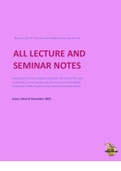Class notes
The Law and Politics on Fencing the Use of Force (S_LPFUF) - all notes of lectures and seminars
- Course
- Institution
All notes of the lectures and seminars of the course The Laws and Politics of Fencing the Use of Force (part of the minor Peace and Conflict Studies (VU)).
[Show more]












